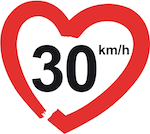Legislation since 1988, allowing municipalities to implement 30-km/h zones, but only few made use of it. Having 30 km/h zones
in front of schools is quite common though. A Belgian network”Ville à 30″ has been established and there are a couple of pioneer
cities today.
| Antwerp/Anvers |
507.900 residents |
30 km/h in the city centre, since 2011. Equals ca 45% of the whole street network, whole municipality is intended to be changed into 30 km/h zone, except arterial roads. This will equal 95% of all roads. |
| Ath |
28.400 residents |
30 km/h in the centre of municipality |
| Bruges |
117.600 residents |
30 km/h in the centre of municipality |
| Brussels |
1.138.900 residents |
| A couple of measures already implemented, and additional measures under planning (70% of road network, proposed in development plannings). Quaters “Schaerbeek” and “Jette” also with 30 km/h zones. Planned: 30 km/h in the city centre (“Pentagon”), except arterial roads. |
|
| Ciné / Ciney |
15.900 residents |
Wide 30 km/h area in the city centre, since 2011 |
| Courtrai / Kortrijk |
75.100 residents |
30 km/h in the centre of municipality, since 2009 |
| Ghent |
249.000 residents |
30 km/h in the city centre, since late 90-ies, also wide pedestrian zone. |
| Hasselt |
75.600 residents |
30 km/h in the centre of municipality, since 2003 |
| Jalhay and Solwaster |
8.400 residents |
30 km/h on all local roads (among the first municipalities which introduced 30 km/h in Belgium. Mountain municipalities with narrow roads, lack of footways) |
| Louvain / Leuven |
97.700 residents |
30 km/h in the centre of municipality, since 2011 |
| Marche-en-Famenne |
17.400 residents |
30 km/h in the centre of municipality |
| Mons |
94.000 residents |
30 km/h in the centre, among the first cities introducing 30 km/h in the late 90ies (?); additional measures for traffic calming; measures to prioritise bicycles |
| Namur |
108.700 residents |
wide 30 km/h zone in the city centre, since 2011 |


